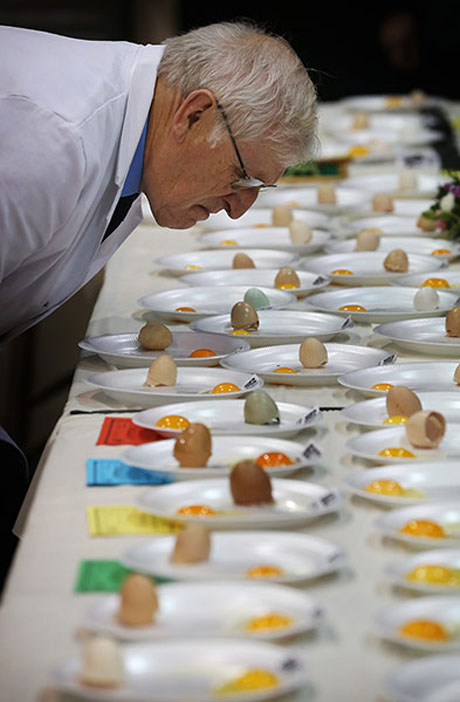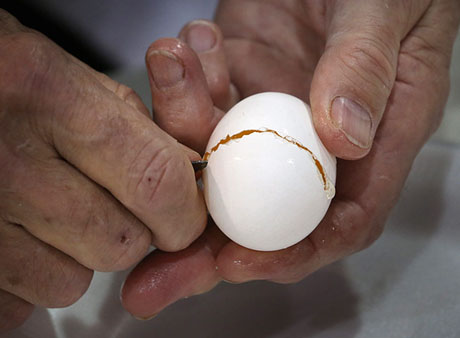Within a delightful slideshow of images from the Poultry Club’s 2012 National Show I found this gem, showing Judge Malcolm Thompson inspecting the UK’s finest eggs.

IMAGE: Judge Malcolm Thompson inspecting eggs. Photograph by Peter Macdiarmid/Getty Images, via The Guardian.
A quick look at the Poultry Club’s website reveals that the art of egg showing is more nuanced than one might expect. For whole eggs, “the egg to show” must approach perfection in “shape, shell texture, colour, and size with a fresh appearance and bloom.” Pointy ends, overlarge pores, “muscle indentations, lime pimples, and bulges” are just a few of the flaws that can put an otherwise perfectly attractive egg out of the running altogether.
Achieving success with a shell-less entry is even more challenging, as, for obvious reasons, exhibitors cannot inspect their specimen before it is put on display at the show. The Poultry Club recommends “opening up a few eggs prior to the show, noting the particular egg with the contents somewhere near the mark, and noting the bird which produces it,” in order to be able to send an egg with a chance of success.
Eggs with pale yolks will be rejected, as will orange and red yolks: instead, “the standard calls for a rich golden yellow.”
See also that the contents stands up well and shows a nice rounded yolk situated as near as possible in the centre of the thick albumen, which should be clear and have a definite outline. At each end of the yolk, the chalazae cords should be visible, as will the blastoderm or germ spot to be found at one side of the centre of the yolk.
With these aesthetic guidelines clearly laid out, the Poultry Club adds a final, useful note on judging freshness (always a slippery attribute). As an egg ages, its water content evaporates through its porous shell, which causes “the contents to ‘flop’ within the shell when the egg is shaken sharply.” Judges will thus “jerk an egg past their ear when judging, listening for a telltale ‘flip’.”
However, even a fresh egg can be made to rattle if shaken too vigorously, the Poultry Club warns, with disastrous consequences for competitive egg exhibitors:
At shows where no barriers are placed between the exhibits and the public, winning eggs can be shaken by all who pass with the result that the end of the day they too will ‘rattle’ and the judge’s reputation is held in dispute. Fresh eggs, when sent to a show by rail or parcel post, also tend to end up rattling on the show bench.
In this instance, there is nothing for it but for the judge to break the egg open, “as empowered to do by Poultry Club Rules,” in order to look for “a large air sac, runny white, and a flat yolk with wrinkled membrane” that would indicate age.

IMAGE: Judge Malcolm Thompson breaks an egg open for inspection. Photograph by Peter Macdiarmid/Getty Images, via The Guardian.
This year, the Powell Owen Cup for Champion Egg Exhibit was awarded to T. McNeight for his “3 Large Cream,” with T. D. Hannam earning the Max Butler Memorial Trophy for Best Egg Contents. Sadly, there are no reports as to whether these ovular beauties made a nice omelette afterward…
Discover more from Edible Geography
Subscribe to get the latest posts to your email.